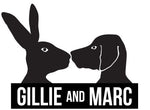
All Bronze Sculptures
Creating bronze sculptures together since 2004, Gillie and Marc have become experts in this medium. To own a Gillie and Marc bronze is very special. Each sculpture is a limited edition that will never be made again. Your sculpture will be a little piece of history that only a few people will have. Each sculpture includes Gillie and Marc’s signature and its own unique edition number. The material is timeless. Using the highest quality bronze, you can be sure that Gillie and Marc’s sculptures will be with you forever. Each sculpture is accompanied by a certificate of authenticity signed by the artists.
Gillie and Marc are animal lovers who have dedicated their lives to protecting animals and have created many bronzes, both monumental public sculptures and miniature home décor pieces, to raise much-needed funds and awareness for endangered animals around the world. When you take home a Gillie and Marc sculpture, you are taking home more than a piece of art. You are taking home love for nature and humanity and becoming part of a movement to spread the message of compassion and conservation.




































































































































































































































































































































































































































































































































































































































































































































































































































































































































































